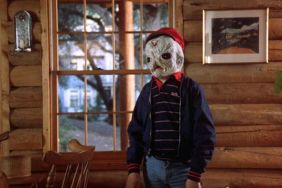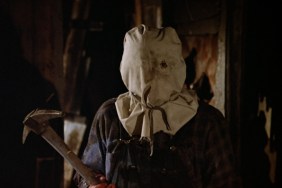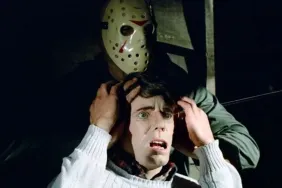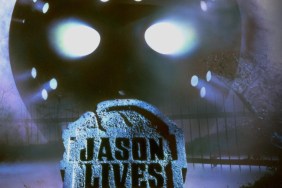Our retrospective series takes us to Crystal Lake

No one trick or treats on the last day of school, no one carves jack o’ lanterns on July 4th, or goes on haunted hayrides in August.
When it comes to beloved macabre traditions, the fall is the season that gets all the attention. Thanks to the celebration of Halloween, the autumn months have always been indelibly associated with all things frightful. Summer, on the other hand, is ostensibly all that horror isn’t about â a golden time of warm weather, trips to the beach, fireworks, road trips and family picnics.
For those movie buffs that prefer the inside of their neighborhood cinemas (or, for some, the nighttime chill of drive-in theaters) to the blistering heat, however, the summer is the real witching season. Some believe that horror vacations in summer, waiting for fall to arrive, but box office history tells a different story.
Starting in 1975 when Jaws invented the modern blockbuster by teaching a generation to be afraid of the ocean, summer has been the best time of year to be scared. The fall can keep Halloween. It can keep the costumes, the candy, the Great Pumpkin, all of it â because summer has always had the better movies.

It’s been derisively said that the Friday the 13th series represents by-the-numbers filmmaking but while there is a formula that the franchise has followed, all body counts are not created equal. In the wake of the sequels that made Crystal Lake’s favorite son into a superstar, it’s sometimes forgotten that in its day, Friday the 13th was a shocker strong enough to rival the then-recent memory of instant classics like Halloween (1978) and Alien (1979); this sleeper hit was a gritty indie with state-of-the-art special effects. The series has changed so much since its humble beginnings that the original Friday the 13th may not be the Friday that fans think of first when they think of the series but I say that first trip to camp remains pure.
While Friday the 13th didn’t have the film geek panache of Brian DePalma’s Dressed to Kill or the mad, meticulous brilliance of Stanley Kubrick’s The Shining, it managed to dust both of those heavy-hitters at the box office during the summer of 1980. Maybe it’s because neither of those movies had director Sean Cunningham’s secret weapon â the Sultan of Splatter, make-up artist Tom Savini. Savini’s previous work on 1979’s landmark Dawn of the Dead led Dawn‘s writer/director George Romero to coin the phrase “splatter cinema” to describe the array of effects Savini devised for the picture. But while Dawn had performed well in theaters, due to its standing as an unrated film (the equivalent of an X) its audience was limited. When the independent production Friday the 13th was picked up by Paramount and given wide distribution as a R-rated film, however, Friday the 13th became the movie that birthed a generation of avid gore hounds.

To jaded modern audiences who have by now seen every possible gore gag there is and are familiar with the mechanics behind most of these effects, it’s impossible to describe how gasp inducing it was in 1980 to see the death of Annie (Robbi Morgan) as her faceless attacker slits her throat. Just the briefest glimpse of that neck wound beginning to open up and gush blood was horrifying. The fact that it took a beat from the time the wound was made until it slowly split apart was what sold the effect. It looked alarmingly real. Today, TV shows like 24 are more violent than any R-rated film from 1980 â for better or for worse, blood and guts are everywhere now in entertainment â but at the time, Friday the 13th owned the market on butchery. Savini’s legendary collaborations with Romero allowed him to cut loose with almost wall-to-wall effects but it’s arguable that Friday the 13th is the finest showcase for his work in that his gags were used more sparingly but with such devastating impact. The famous arrow-through-the-throat death of Jack (Kevin Bacon), in particular, is still (pardon the expression) perfectly executed.
While all the bloodletting may have been too ghoulish for some to stomach, the realism of the effects was countered by a giddy disregard for the laws of physics that kept the film from becoming oppressive. Only in the world of Friday the 13th could a middle-aged woman hurl a full-bodied, twentysomething girl through a window, as Mrs. Voorhees (Betsy Palmer) does to the slain Brenda (Laurie Bartram). And even more incredible is Mrs. Voorhees’ ability to single-handedly lift the dead body of Bill (Harry Crosby) off the ground and impale him against a door with multiple arrows penetrating his body. How, exactly, was that accomplished? It defies explanation, as does Alice’s climatic decapitation of Mrs. Voorhees. Even Conan the Barbarian couldn’t sever Thulsa Doom’s head with just one swipe of his father’s sword. He had to give it at least two hacks. But yet Alice (Adrienne King) lops off Mrs. Voorheesâ head as easily as cutting through butter. That’s some upper body strength for a young lady â and one hell of a machete, too! But moments like that only added to the vibe that this was all meant to be in fun, that Friday the 13th wasn’t a sordid, slavering invitation to celebrate the mutilation of the human body but instead was a campfire story pimped out with miraculous magic tricks.

Savini’s history-making effects have commanded so much attention over the years that, as a result, Sean Cunningham has rarely gotten much credit for what he brought to the film but yet Friday the 13th is the work of a director with a canny instinct for playing the audience (Jason’s jump from the lake still ranks as the best final scare ever). Friday the 13th‘s success might have been a happy accident in many respects â a matter of being the right film at the right time â but yet the film itself isn’t haphazard moviemaking. There’s nothing fancy about Friday the 13th but in its down and dirty effectiveness, it reflects Cunningham’s seasoned skills as an independent filmmaker. One can’t quite call Friday the 13th gritty but it does have an almost vérité style. Just by watching the movie, I feel like I’ve been to those locations, walked in those woods, and been in those cabins. In tandem with the appealingly amateurish performances of the largely neophyte cast members, nothing in Friday the 13th feels set-designed or art-directed. It feels like all of the clutter we see on shelves and tables is just as it was before the cameras came in.
What really sets Friday the 13th apart from the rest of the franchise, though, is the presence of Pamela Voorhees as the killer. For my money, Jason was never as scary as his mother. Maybe it’s that thick cable knit sweater that makes her look kind of jacked. Maybe it’s her scary man hands that we sometimes see in close-up (which actually belonged to Savini’s assistant, Taso N. Stavrakis). Whatever it is about her, when Mrs. Voorhees whips into action, turning on Alice after telling the tale of Jason’s drowning, it’s genuinely hair-raising.

Betsy Palmer gives a performance that carries just the right mix of real emotion (“Jason should’ve been watched â every minute!”) and stylized villainy (“Kill her, mommy! Kill her!”). Her screen time may be limited (and her nearly last minute introduction into the film points up what a cheat the film’s mystery angle has been) but Palmer is able to create a lasting legend. Besides Palmer’s acting chops, her ability to play rough with Adrienne King (and visa versa) during their final battle is commendable. It may not be the sexiest of catfights, but even after all the brutal, bloody sights the movie has had to offer, there’s something about seeing Mrs. Voorhees repeatedly pound Alice’s head into the shore of Crystal Lake that’s, well, crazy.
Just as Jaws (1975) changed the way we look at the ocean, after Friday the 13th it was impossible to ever think of summer camp the same way again. The series also made it impossible to think of hockey masks the same way again â but that’s a tale for another sequel, and another summer. For those old enough to have known a time when Jason was only seen in a flashback â floundering for help in the waters of Crystal Lake â or as the moss and algae covered boy seen in Alice’s dream, the impact of the original Friday the 13th remains a crystal clear memory.
The Shining (May 23rd)
Dressed to Kill (July 25th)
Prom Night (August 15th)
He Knows Youâre Alone (August 29th)
The Amityville Horror (Jeff Allard)
Phantasm (Ryan Turek)






Source: Jeff Allard









